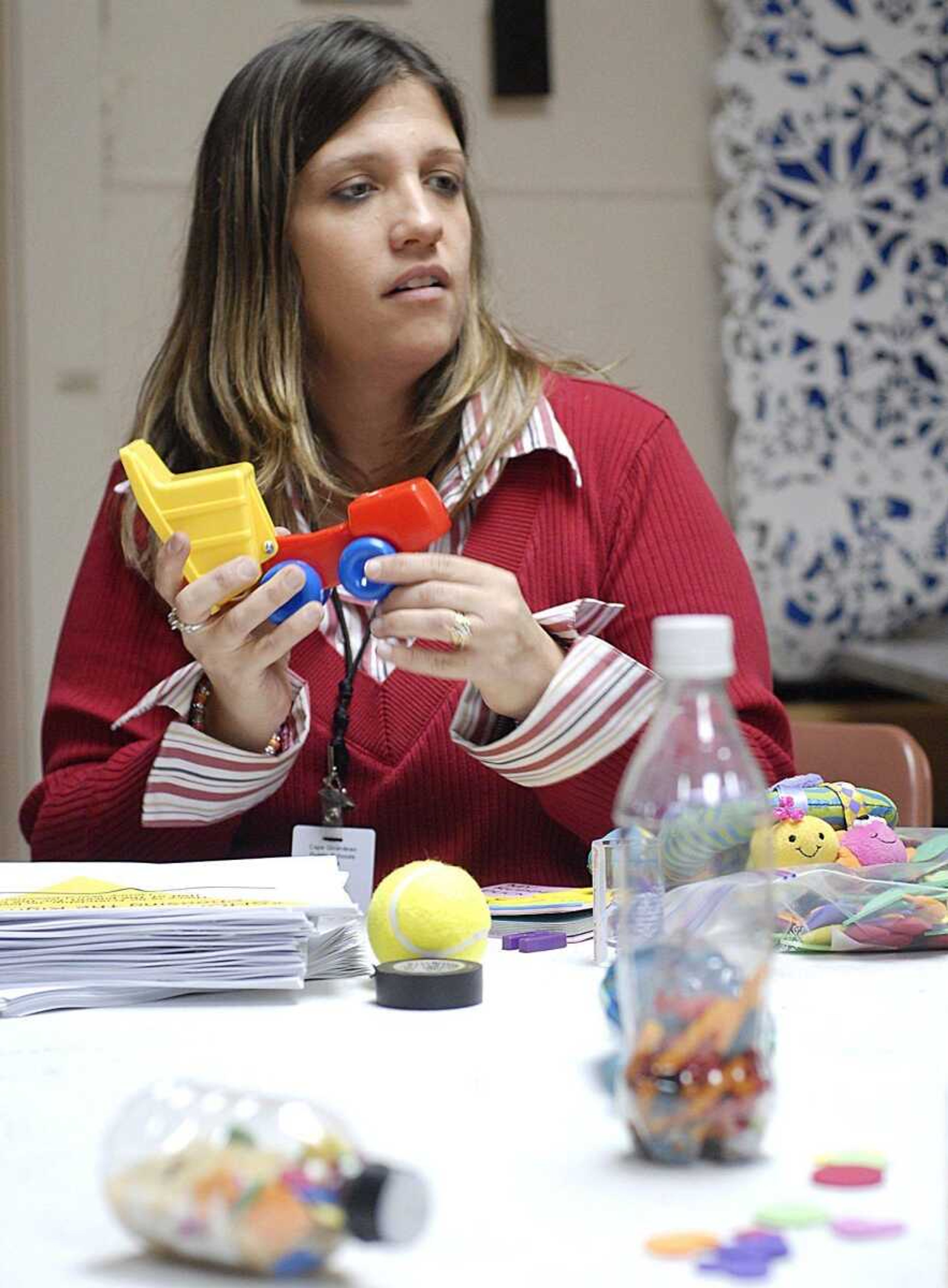Stephanie Ellinger, parent educator at Cape Girardeau School District's Parents as Teachers program, presented a free program called "Shopping for Toys 101" on Tuesday at the Family Resource Center. The presentation focused on toy safety and the age-appropriate selection of toys. Participants made a shaker bottle toy to take home. It was sponsored by the Primary Care Coalition of the Community Caring Council.
The presentation informed parents, caregivers and other consumers of the seven dangers regarding toy safety: sharp edges or points, small parts, loud noises, propelled objects, electric toys, lead paint and selecting the wrong toy for the wrong age.
"It is the role of the parent to really examine toys before purchasing and continue to observe while a child is playing with the toy for good safety measure. Wear and tear can cause a toy to become dangerous. Parent supervision is essential," Ellinger said.
The American Academy of Pediatrics advises consumers to pay attention to printed age recommendations on packages. They reflect the safety of a toy based on the safety aspects of the toy and any possible choking hazards, the child's physical ability to play with the toy, the child's ability to understand how to use a toy and the needs and interests at various levels of a child's development.
Choke tubes that are about two inches in diameter are available. The rule is that if an object does not fit down the choke tube, the child cannot choke on it. Ellinger explained that an ordinary toilet paper tube serves the same purpose without cost. She added that the safety of any toy is not guaranteed.
Adding to the list of dangers, the AAP advises avoidance of parts on toys that could pull off and/or fit into a child's mouth, nose or ear; exposed wires and parts that get hot; toxic materials; breakable parts; glass or thin parts; springs, gears or hinged parts that could pinch tiny fingers or become caught in infants' or toddlers' hair.
Age guidelines
- For babies up to 18 months old, rattles, stacking toys, squeaky toys, floating tub toys, blocks, nested boxes or cups and books are suggested.
- Suggestions for toddlers 18 months to 3 years old include a tricycle/ride-on toy, wagon, push-pull toys, balls, play kitchen or tool bench, dolls, stuffed animals, games, crayons, finger paints and clay.
- Appropriate for 3- to 5-year-olds are puppets, playhouses, a radio/CD player, train/race car set, planes, boats, small cars, a bike with helmet and books.
With the recent issues of lead in toys and the subsequent recalls, parents may need to be more informed about purchasing and even accepting hand-me-down toys from relatives or friends. A list of toy recalls from 1974 to 2007 can be obtained at www.cpsc.gov/cpscpub/prerel/category/toy.html, from the U.S. Consumer Product Safety Commission or by calling 800-638-2772. This number can also be used to report a toy that may be unsafe. Most stores and doctors' offices post recent toy recall sheets as well.
According to toyinfo.org, a resource for facts and information about toy safety, the toy industry spends about $300 million a year on safety testing and inspection of toys and has recently increased its efforts above that figure.
Companies are putting special focus on assuring the safety of painted toys for young children by sending them back to laboratories for retesting. They are also purchasing sophisticated lead testing equipment for spot checks in warehouses and distribution centers.
The AAP thinks most toys on the market are safe. However, just last year an estimated 140,700 children were treated in U.S. emergency rooms after toy-related incidents, and 13 children died. By knowing what to look for when purchasing toys and practicing a few ideas for safe use, preventing problems is often possible.
Those interested in becoming part of the Parents as Teachers program may call 651-3703. The program is a parent education and family support program available throughout pregnancy until their child enters kindergarten.
cpagano@semissourian.com
335-6611 extension 133
Were you there?
Have a comment?
Log on to semissourian.com/today
Connect with the Southeast Missourian Newsroom:
For corrections to this story or other insights for the editor, click here. To submit a letter to the editor, click here. To learn about the Southeast Missourian’s AI Policy, click here.







